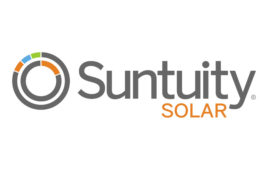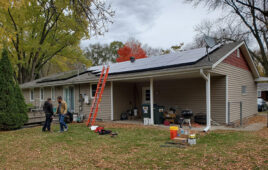
Nevada’s constitution has been officially amended to include a mandate for utilities to source 50% renewable energy by 2050.
Nevada voters officially approve new renewable energy standard
Carson City, Nevada
Nevada’s Question 3 constitutional amendment was approved by voters for the second and final time in order for it to become law, according to Law360.com. The law requires utilities to use at least 50% renewable energy by 2030, with an early goal of 22% renewables by 2022.
SEIA releases solar policy goals for first 100 days of Biden administration
Washington, D.C.
After Joe Biden and Kamala Harris were elected in the 2020 presidential election, solar and storage advocacy groups expressed hope for renewable energy growth under the new administration. SEIA released a set of policy goals for the Biden administration to consider, including investing in renewable energy infrastructure and simplifying permitting nationwide.
Trump administration finalizes exit from Paris Agreement
Washington, D.C.
The Trump administration officially finalized the U.S. exit from the Paris Agreement in November 2020. Although the decision was announced previously, the withdrawal could only be finalized as soon as the day after the presidential election. President-elect Biden vowed to rejoin Paris on Day 1 of his administration.
CALSSA calls for ten legislative actions to drive solar + storage growth in California
Sacramento, California
The California Solar and Storage Association released a plan to use local solar + storage to drive COVID recovery and improve energy resilience in the state. The group’s plan calls for state leaders to move to automated permitting and virtual inspections, allow customer batteries to assist in grid emergencies and more.
Illinois Clean Energy Jobs Act now stalled until 2021
Springfield, Illinois
Illinois’s Clean Energy Jobs Act will now have to wait until 2021 to be deliberated further after the state canceled its November legislative session due to the COVID surge, according to the Energy News Network. Illinois reached a solar funding cliff in early 2020, so the additional funding CEJA would authorize the state to collect through customer utility bills is crucial to the state’s solar growth.
90% of Pennsylvania Solar PAC-endorsed candidates won electoral races
Harrisburg, Pennsylvania
The PA Solar PAC, an organization that supports Pennsylvania candidates in favor of strong solar policies, found 90% of its endorsed candidates for the General Assembly won election or re-election in the 2020 general election. The group says this shows voters in the state want to be represented by legislators who value solar energy’s role in the economy.
New Jersey bill to establish Office of Clean Energy Equity passes state Senate
Trenton, New Jersey
The New Jersey Senate passed a bill that would establish an Office of Clean Energy Equity to oversee fair distribution of clean energy programs and provide green job opportunities to underserved communities. The bill requires workforce training for 2,500 people by 2025. It moves on to the state’s House of Representatives next.
Bifacial solar panels lose Section 201 tariff exemption
Washington, D.C.
Bifacial solar panels are no longer exempt from Section 201 tariffs after a new United States Court of International Trade ruling. In October, President Trump issued an executive order recommending an end to the bifacial exemption.
Illinois Commerce Commission vote reinstates full retail net-metering for Ameren customers
Springfield, Illinois
The Illinois Commerce Commission voted to reject Ameren Illinois’s calculation of the number of solar net-metering customers in its territory, an issue raised by clean energy groups earlier this year. The ICC’s ruling means new solar customers in Ameren territory can again receive full retail net-metering benefits.
Renewable energy incentives run out in central and southern Illinois
Springfield, Illinois
The Illinois Power Agency announced state renewable energy incentive money has run out in central and southern Illinois, with northern Illinois expected to join the list in the coming days. The advocacy group Path to 100 has continued to argue for legislative action to fund renewable energy in the state and introduced the Path to 100 Act in early 2019 to address the problem, but the bill has yet to be called for a vote.
Advocacy groups release best practices for siting solar near Virginia’s historic landscapes
Richmond, Virginia
Three Virginia preservation advocacy groups issued a report on best practices for siting utility-scale solar projects that do not encroach on the state’s wealth of historic resources like Civil War battlefields. The groups acknowledge that clean energy and preservation go hand in hand and say tension between the groups can be avoided with careful planning.





“The law requires utilities to use at least 50% renewable energy by 2030, with an early goal of 22% renewables by 2022.”
The reality of (making it happen), 50% RPS by 2030 will cost the ratepayers about 4% increase in electricity rates per year for the next 10 years. Take the average electric bill in Nevada right now and multiply by 0.40 then add that to your bill now and see where that puts you in 2030. Does your own personal solar PV home system look better now?
“The California Solar and Storage Association released a plan to use local solar + storage to drive COVID recovery and improve energy resilience in the state. The group’s plan calls for state leaders to move to automated permitting and virtual inspections, allow customer batteries to assist in grid emergencies and more.”
This is the consequence of mandates pushing 100% decarbonization in California by 2045. Note the “dependence” on (state leaders) to make this agenda possible. On the other hand if one can go to Google Earth and begin designing a solar PV system for your roof, automated permitting and virtual inspections are viable. So far it has been deemed necessary for the electric utility and all interested parties to be on site to witness the system start up and conformance to NEC, utility and sometimes local Fire Marshall requirements.
“The Illinois Commerce Commission voted to reject Ameren Illinois’s calculation of the number of solar net-metering customers in its territory, an issue raised by clean energy groups earlier this year. The ICC’s ruling means new solar customers in Ameren territory can again receive full retail net-metering benefits.”
This is only as good as the (cap) which I believe was stated at 5%, not very high in this day and age. When many States of the Union are pushing for RPS of 50% by 2030 5% is laughable and a more sustainable program going forward is needed sooner than later.